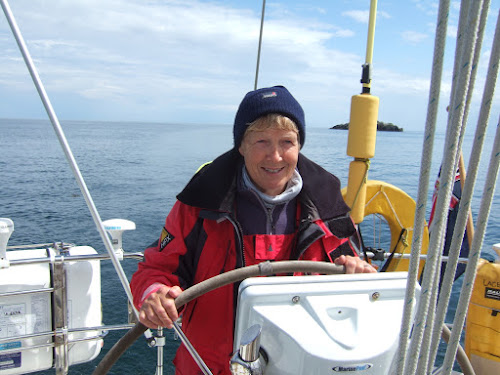Saturdays sail across the Little Minch to Harris in the Outer Hebrides proved to be very frustrating. We stayed in Loch Snizort for most of the morning, waiting for the strong Easterly winds to veer to the South and ease off and the rain squalls to die down. We eventually left just after midday, running down the Loch at 7 knots with just the partially furled genoa, which would have made a very quick passage across to Scalpay, a small island at the South end of Harris. As we left the shelter of the loch and headed out into the Minch the wind did start to ease. With the forecast force 3 or 4 we expected to be able to hoist the mainsail and set the genoa on the spinnaker pole on the opposite side ( goose winging) and still have a fast passage. As we hoisted the mainsail the wind dropped still further and with the swell there wasn't enough to keep the sails full so we had to revert to the engine. The monotony of the trip was relieved a little by spotting wildlife, the list of sightings included a curious seal, a pod of dolphins, guillemots, Debbie's favourite puffins, gannets, very elegant in flight, razor bills, oyster catchers, arctic skuas and terns, we are trying to identify the different species of tern but for now they all have to be just terns!
With about 4 miles to go the wind decided to pick up again so we were able to get some decent sailing for the last 3/4 of an hour until we got to the bridge connecting Scalpay to the rest of Harris. Even though I had checked the clearance (20 metres against our 15.8 metre air draft), Debbie still cringed as we passed under!
A short distance further on, after negotiating a few rocks we entered the North Harbour of Scalpay, a small, almost totally landlocked natural harbour on the West side of the island. With 3 yachts already anchored it seemed positively crowded, we had to motor around for a while to find enough depth, clear of the other yachts, for us to anchor. Even then we had to make do with a 1/2 metre margin at low water rather than the 1 metre minimum below the keel that I prefer. For such a small island the construction of a road bridge seemed to be a very expensive undertaking. There must be a profitable fishing and processing industry to justify it, certainly the pier in the North Harbour was crowded with fishing boats.
We originally planned to go ashore on Sunday morning but with strong spring tides in the Sound of Shiant to the North of us we decided to move on in the morning and make use of as much favourable tide as possible, no wind again so the engine was called into use again. We planned a fairly short trip to Loch Mariveg, 20 miles further North. Loch Mariveg is another small natural harbour, protected by a number of small rocks and islets so it is almost perfectly sheltered from all wind directions. The entrance channels are narrow but deep with rocks rising either side of us as we made our way in.
It had rained for most of the trip, with the Admiral on watch in the rain but the sun came out as we made our way into the loch and anchored close to the shore in the SE corner as the pilot book suggests. Stunning is the only word to describe the place. We could have chosen one of about half a dozen protected anchorages on the way in with only seals for company. Although the village of Marvig, scattered houses around the loch, appeared remote, it seemed to be successful. On our walk ashore we met a young couple with their young son and new baby daughter who had just built a stunning house facing the water with a large boat shed and slipway close by to run a boat building and repair business. Their children would go to the local school 4 miles away, there would be about 6 of the same age in a class, very different to when ours went to school, and what a place to be able to grow up and play.
Yet again the weather was set to deteriorate so we planned an even shorter trip on Monday, 8 miles to Stornoway, where we could stay for a couple of nights while the bad weather went through and stock up with provisions and fill the diesel and water tanks and the gas bottles. As we head around Cape Wrath towards the Orkneys there are limited places where we can do this and lie alongside a pontoon.
The trip turned out to be an excellent, if short, sail. Bright sunshine and a pleasant following breeze. No engine required today! We were tied up to a pontoon in Stornoway's very sheltered marina before lunch and have booked a hire car for tomorrow to see a bit more of the rest of the island.








No comments:
Post a Comment